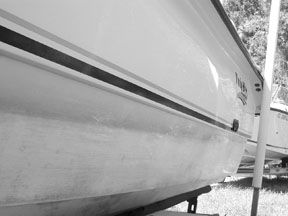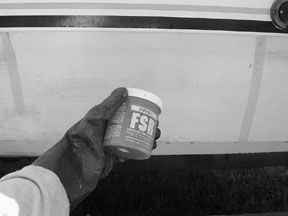Of all the stains a fiberglass hull will be subjected to in its working life—rust, oil, blood, and diesel exhaust, none, at least in our experience can be as tough to remove as a boat-long streak adorning the waterline. Sometimes this is the only blemish on an otherwise sparkling hull, and one that only an owner would notice. Other times, these streaks manifest themselves as ugly, tea-colored stains that make the boat look 10 years beyond its actual age.

While these stains can result from a variety of factors—algae, petrochemicals and, in fresh or brackish water, tannin—most are the result of metallic salts caused by the interaction of dissolved metals in the water and air. Stains like these are similar to the brown or green discolorations that often appear in a toilet bowl.
Detergents, such as the ones that are present in most hard-surface cleaners, when used by themselves will have little or no effect on these waterline stains; acids, however, do a good job of removing them. The marine industry has created specialized waterline stain removers that, depending on what has caused your streaks, may not be strong enough to do the job or may prove to be overkill. And it’s always best to keep in mind that the products which work the fastest and the most thoroughly on your hull, may also damage your gelcoat.
Generally, stains are removed either by surface cleaning—as with detergents/chelating agents (chemical compounds that break up others)—or by etching with acids, or ultimately by abrasion. The stronger acids and more abrasive substances will take the stain off more effectively, but your hull will gradually lose some luster, and become susceptible to staining more quickly in the future. You can limit that kind of damage by avoiding abrasive liquids and pads that can scratch, and by washing the acids off as soon as they’ve done their job.
What We Tested
The test specimens included seven cleaners from different manufacturers obtained at several local marine stores. We chose only those that claimed they were suitable for cleaning waterline stains. The products were FSR fiberglass stain remover from Davis, Y-10 stain absorber, 3M Marine Heavy Duty Hull and Deck Cleaner, Aurora Waterline Stain Remover, Toon-brite, Marykate On & Off, and West Marine Hull Cleaner. We did not use any abrasive products or cleaning pads, only the materials called for by the respective directions, which usually meant a cloth, sponge, and brush, or simply fresh water.
As a test platform, we elected to use our Florida-based Twin Vee Awesome 22 (a test boat we share with Powerboat Reports), due to the thick, very noticeable stain spanning its entire waterline. The stain was worse on the port side, so that’s where we performed our test.
Using standard masking tape to section off the hull, we created seven different areas for the seven different products to work their respective magic. Each area was a little over two feet long with the stain varying from four to six inches in height.
We assiduously followed the directions listed on each product. For instance, if the instructions said to wait 20 minutes after application, that’s exactly what we did.
A Word About Safety
Manufacturers of cleaning products advise that you wear adequate protective gear, including gloves. Most of the cleaners we looked at contained some fairly strong acid combinations (including hydrochloric, phosphoric, and oxalic acids) that definitely require gloves—the longer the better. For this test, our gloves extended nearly to the elbows.

If you work with this stuff, watch out for errant drippings. These acids aren’t as strong as what oozed out of the monster in “Alien” and ate through five steel decks, but they’re potent enough to stain wood and burn skin. And some of these cleaners generate corrosive fumes that you don’t want to breathe, so work upwind of the spot you’re cleaning. And, in addition, wear some form of eye protection.
What We Found
FSR. From Davis Instruments, FSR (Fiberglass Stain Remover) is a dark-blue, gel-like product that relies on oxalic acid as its active ingredient. It is also sold under the West Marine brand (Model 364069, page 463 in the 2004 catalog). You’re instructed to shake, apply with cloth, brush or sponge on, wait a few minutes, and then rinse or wipe off. We found that getting the gel out of the container was a little messy. It might be better to first transfer the contents into a wide-mouthed dish. But FSR worked well, cleaning virtually the entire stain.
Y-10. This product also contains oxalic acid and comes in a gel-like form. It is intended to be applied with a brush and removed (no time is suggested) with a cloth and liquid detergent. The Y-10 container has a wider opening than the FSR, making it easier to dispense. This product cleaned its portion of the waterline slightly better than the FSR.
3M Marine. The Heavy Duty Hull and Deck Cleaner from 3M contains sodium carbonate, sodium hydroxide, as well as a “trade secret,” and it comes in a spray bottle that makes it more convenient to use than the gels, in our view. The directions say to spray directly on and use a soft brush to clean. It did not remove any noticeable amount of stain from its test area.
Aurora. The active ingredient in Aurora Waterline Stain Remover is hydrogen chloride, which is fairly potent, creating corrosive fumes that should be avoided (the label carries this warning). The product is a liquid and comes in a pint-sized bottle. Instructions call for application with a chemically resistant roller, then letting it stand 20 to 30 minutes. This product worked very well—the best of the bunch—leaving a nice expanse of white gelcoat.
Toon-brite. This product contains blended acids—sulfuric and hydrochloric. It comes in a one-liter bottle with a detachable spray nozzle and a small section of hose to connect the two. Instructions say to spray on and let stand up to five minutes, but make sure you don’t let it dry. Then you rinse it off. Because the bottle and spray are separate components, you end up holding and pumping using both hands. With our bulky gloves on, this was a little difficult to do. The product requires no rubbing or scrubbing, just a rinsing with water. It removed the majority of the stain, working almost as well as the Y-10 and FRS products.
West Marine Hull Cleaner. This liquid cleaner, which contains phosphoric acid, is applied with a sponge or a trigger sprayer (not included). You let it soak in for two to three minutes, and then rinse with water. It comes in a one-quart, cylindrical bottle that we squeezed too hard when picking up and it burped out some of its contents accidentally. It worked OK, getting off about half of the stain.

Marykate On & Off. This product was tested in our barnacle remover test (see May 1, 2004 issue). It was included here because the bottle says it is also effective for “browning waterline stains.” Marykate On & Off contains hydrochloric, phosphoric, and oxalic acids. Directions say apply with a natural bristle brush, then rinse immediately. We found it to be on the same performance level as the FSR and Y-10 products, but it didn’t work as well as the Aurora cleaner.
Conclusions
If your boat is afflicted with a nasty waterline stain, you might as well go with the toughest stuff—the Aurora Waterline Stain remover. Yes, it’s toxic, and not much fun to work with, but it’ll do the job in one pass so you can get back to actually enjoying your boat. Suitably impressed, we used the Aurora to clean the rest of our boat.
The runners-up in this test are the Y-10 and FSR waterline cleaners, which are slightly less toxic. Both would be good for lighter duty stains. Marykate On & Off and Toon-brite also did a respectable job on our waterline.
Again, if you end up using the stronger stuff, be sure to wear protective clothing from head to toe—and work in a well ventilated area.
Also With This Article
“Value Guide: Waterline Cleaners”
Contacts
• Aurora Marine Industries, 905/564-4995, www.auroramarine.com
• FSR, Davis Instruments, 510/732-9229, www.davisnet.com
• MaryKate, 631/244-8550
• West Marine, 800/262-8464, www.westmarine.com
• Y-10, 203/637-9515
• Toon-brite, 800/280-3933, www.melleemarine.com
• 3M, 877/366-2746, www.3m.com/US/auto_marine_aero/marine/







































